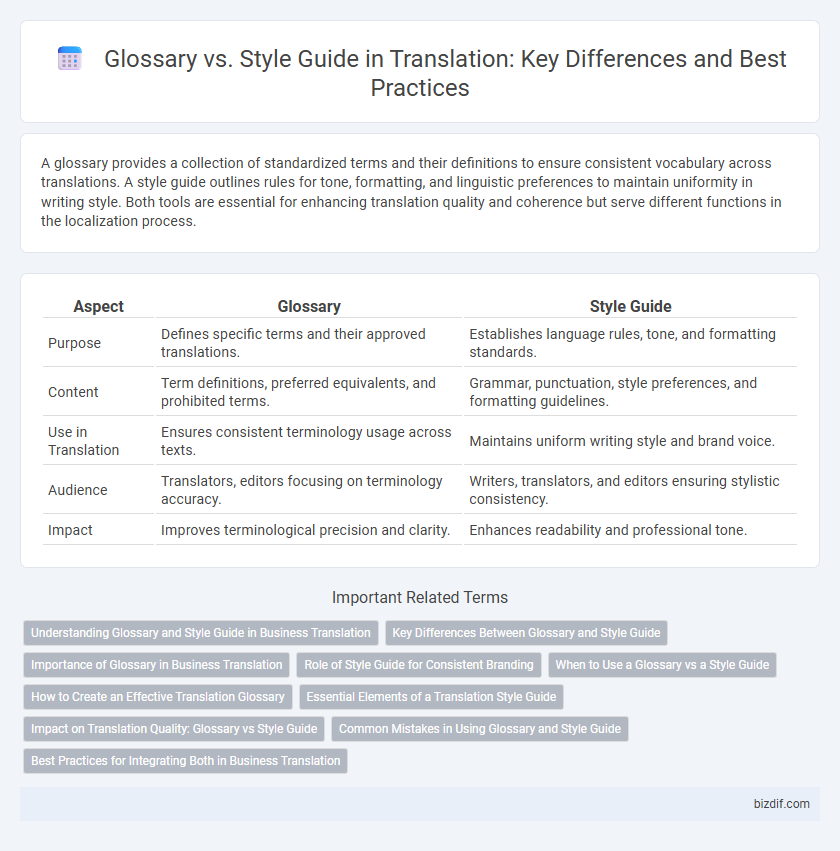A glossary provides a collection of standardized terms and their definitions to ensure consistent vocabulary across translations. A style guide outlines rules for tone, formatting, and linguistic preferences to maintain uniformity in writing style. Both tools are essential for enhancing translation quality and coherence but serve different functions in the localization process.
Table of Comparison
| Aspect | Glossary | Style Guide |
|---|---|---|
| Purpose | Defines specific terms and their approved translations. | Establishes language rules, tone, and formatting standards. |
| Content | Term definitions, preferred equivalents, and prohibited terms. | Grammar, punctuation, style preferences, and formatting guidelines. |
| Use in Translation | Ensures consistent terminology usage across texts. | Maintains uniform writing style and brand voice. |
| Audience | Translators, editors focusing on terminology accuracy. | Writers, translators, and editors ensuring stylistic consistency. |
| Impact | Improves terminological precision and clarity. | Enhances readability and professional tone. |
Understanding Glossary and Style Guide in Business Translation
A glossary in business translation ensures consistent use of terminology by providing a predefined list of approved terms specific to the industry or company. A style guide complements this by outlining tone, formatting, and language preferences to maintain brand voice and professionalism across all translated materials. Together, these tools enhance accuracy, coherence, and efficiency in multilingual communications.
Key Differences Between Glossary and Style Guide
A glossary provides a list of domain-specific terms with their definitions to ensure consistent terminology usage across translations. A style guide offers detailed instructions on language style, tone, grammar, punctuation, and formatting for maintaining uniform writing quality. Glossaries focus on vocabulary accuracy, while style guides emphasize the overall linguistic presentation and coherence in translation projects.
Importance of Glossary in Business Translation
A glossary in business translation ensures consistent terminology across all documents, enhancing clarity and professionalism in communications. It prevents misunderstandings by standardizing industry-specific terms, which is crucial for maintaining brand integrity and compliance with legal requirements. Using a glossary reduces translation errors and accelerates the translation process, ultimately saving time and costs for businesses.
Role of Style Guide for Consistent Branding
A style guide establishes uniform language, tone, and formatting rules that ensure consistent branding across all translated content. It complements a glossary by providing broader guidelines on voice, punctuation, and cultural nuances critical for maintaining brand identity. Consistency in style reinforces brand recognition and fosters trust among diverse global audiences.
When to Use a Glossary vs a Style Guide
A glossary is essential for ensuring consistent terminology and clear understanding of specialized or technical terms within a translation project, especially when industry-specific language must be preserved. A style guide is useful for maintaining uniform writing conventions, tone, formatting, and punctuation, which is crucial when adapting content for a specific audience or brand identity. Use a glossary to manage vocabulary precision, and rely on a style guide to enforce standardized language style and presentation.
How to Create an Effective Translation Glossary
Creating an effective translation glossary involves compiling a comprehensive list of key terms with accurate definitions, context-specific usage, and approved translations to ensure consistency across all translated materials. Incorporate industry-specific terms, brand names, and frequently used phrases, while regularly updating the glossary to reflect evolving language and terminology. Collaborate closely with subject matter experts and native speakers to maintain clarity and cultural relevance, enhancing overall translation quality.
Essential Elements of a Translation Style Guide
A translation style guide must include essential elements such as terminology consistency achieved through a comprehensive glossary, ensuring accurate use of industry-specific terms and brand language. Guidelines for tone, voice, punctuation, and formatting standardize the translated content to match the source material's intent and target audience expectations. Clear instructions on grammar rules, localization preferences, and target dialect nuances further enhance translation quality and coherence across all multilingual projects.
Impact on Translation Quality: Glossary vs Style Guide
A glossary ensures consistent terminology usage, reducing errors and improving accuracy in translation projects. A style guide impacts tone, formatting, and language preferences, enhancing readability and cultural appropriateness. Combining both tools maximizes translation quality by addressing terminology precision and stylistic coherence.
Common Mistakes in Using Glossary and Style Guide
Common mistakes in using a glossary and style guide include treating terms and language rules interchangeably, leading to inconsistent translations and tone. Glossaries should strictly define terminology, while style guides govern overall language style and formatting, ensuring uniformity across documents. Failure to distinguish these roles often results in errors such as incorrect term usage or inconsistent writing styles that impact translation quality.
Best Practices for Integrating Both in Business Translation
Integrating a glossary and style guide in business translation ensures consistent terminology and tone across all documents, enhancing brand identity and communication clarity. Establish clear protocols for updating both resources regularly based on client feedback and industry changes to maintain accuracy and relevance. Utilize translation management systems that support glossary and style guide integration to streamline workflows and improve translator efficiency.
Glossary vs Style Guide Infographic

 bizdif.com
bizdif.com